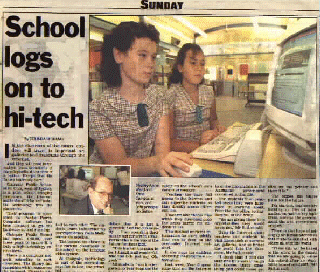

This page is taken from the article which appeared with photographs in the Sunday Telegraph Mirror of 24 March 1996
In the classroom of the future, children will travel to important art galleries and museums through the Internet, and they will read information from thousands of encyclopaedia at the click of a button. Except that the future is already here!
Clairgate Public School, at St Clair, west of Sydney, is a pilot school bringing computers, the Internet, audio-visual links and satellite technology into the classroom.
Clairgate Public School has spent $100,000 over three years to ensure it is truly a high-technology environment. Their project is sponsored by Pacific Power, and additional Computer software has been donated to get the hardware up and running.
There is a computer network extending to each classroom. The library has computers which can access the Internet. There is one which relays pictures, sound and text to one of a few NSW schools which have the same technology, allowing students to see and talk to each other. The students learn Indonesian by correspondence from Melbourne via satellite. The lessons are shown in the various classrooms in the school on the in-house video system.
At Clairgate, technology is part of the curriculum, says Ian Sutton, the principal.
"It is just mind-boggling what you can do, but it has to be curriculum-driven, the whole thing", he said.
"If it is not curriculum-driven then it is just a gimmick. And the community ...I am spending their money just for toys in a way. For me this is the way of the future for these kids. ...This is what it is going to be. I think it is all wonderful And the kids just say, `Oh, yeah'."
All students from kindergarten to Year 6 can use the Internet.
The school has set up a proxy server system, so information gathered from the Internet can be downloaded and stored indefinitely on the school's own computer memory.
Teachers too have full access to the Internet and can supervise students as they directly access different files.
Teachers also choose files which they download onto the proxy server for students to use. This method retrieves information far more quickly than can be done on the overloaded Internet network. It also stops the children accessing inappropriate information.
Last week, Year 6 spent some time on the Internet looking up information for a project on the Australian government. They found the home page, which is like the contents of a book, and points to all the information on the Australian government contained in that file. The students then selected areas they were interested in learning about, from the tax office, to Parliament, or the Army.
"We are giving these kids opportunities they would never get", Mr Sutton said.
"Using the Internet allows teachers and students to visit places such as overseas art galleries, and so brings the world into the classroom", Mr Sutton said.
"I think that if you can take kids for a walk through the Louvre, that's something you could never get otherwise", he said.
"You can't stand up and give a lesson: `Here's this famous art gallery' and you hold up the picture. Whereas on the Internet they can click on the pointer and there it is."
The school has bigger plans for the future.
For starters, teachers are building up files of information on various key topic areas, such as the environment, the arts, government or sport. There is also a plan to give personal chat addresses for each student so that they can chat one-to-one with others all over the world.
"These kids will be linked to the world to the extent that we are going to name this school after an Australian icon of some sort", Mr Sutton said.
"So that if someone in California wants to talk to Billy Smith in the Wattle Room at Clairgate, they can just come down the line and they will be able to do so."